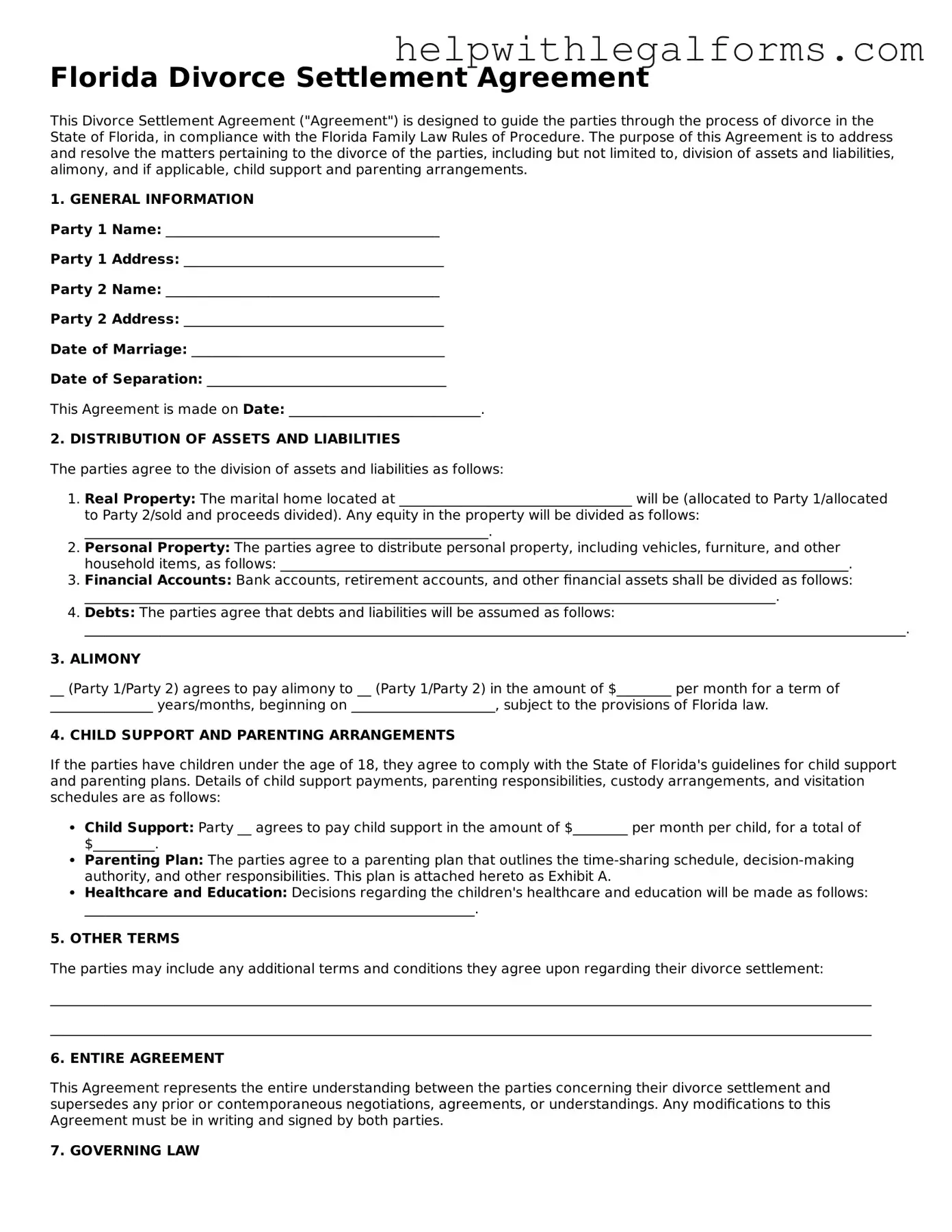Florida Divorce Settlement Agreement
This Divorce Settlement Agreement ("Agreement") is designed to guide the parties through the process of divorce in the State of Florida, in compliance with the Florida Family Law Rules of Procedure. The purpose of this Agreement is to address and resolve the matters pertaining to the divorce of the parties, including but not limited to, division of assets and liabilities, alimony, and if applicable, child support and parenting arrangements.
1. GENERAL INFORMATION
Party 1 Name: ________________________________________
Party 1 Address: ______________________________________
Party 2 Name: ________________________________________
Party 2 Address: ______________________________________
Date of Marriage: _____________________________________
Date of Separation: ___________________________________
This Agreement is made on Date: ____________________________.
2. DISTRIBUTION OF ASSETS AND LIABILITIES
The parties agree to the division of assets and liabilities as follows:
- Real Property: The marital home located at __________________________________ will be (allocated to Party 1/allocated to Party 2/sold and proceeds divided). Any equity in the property will be divided as follows: ___________________________________________________________.
- Personal Property: The parties agree to distribute personal property, including vehicles, furniture, and other household items, as follows: ___________________________________________________________________________________.
- Financial Accounts: Bank accounts, retirement accounts, and other financial assets shall be divided as follows: _____________________________________________________________________________________________________.
- Debts: The parties agree that debts and liabilities will be assumed as follows: ________________________________________________________________________________________________________________________.
3. ALIMONY
__ (Party 1/Party 2) agrees to pay alimony to __ (Party 1/Party 2) in the amount of $________ per month for a term of _______________ years/months, beginning on _____________________, subject to the provisions of Florida law.
4. CHILD SUPPORT AND PARENTING ARRANGEMENTS
If the parties have children under the age of 18, they agree to comply with the State of Florida's guidelines for child support and parenting plans. Details of child support payments, parenting responsibilities, custody arrangements, and visitation schedules are as follows:
- Child Support: Party __ agrees to pay child support in the amount of $________ per month per child, for a total of $_________.
- Parenting Plan: The parties agree to a parenting plan that outlines the time-sharing schedule, decision-making authority, and other responsibilities. This plan is attached hereto as Exhibit A.
- Healthcare and Education: Decisions regarding the children's healthcare and education will be made as follows: _________________________________________________________.
5. OTHER TERMS
The parties may include any additional terms and conditions they agree upon regarding their divorce settlement:
________________________________________________________________________________________________________________________
________________________________________________________________________________________________________________________
6. ENTIRE AGREEMENT
This Agreement represents the entire understanding between the parties concerning their divorce settlement and supersedes any prior or contemporaneous negotiations, agreements, or understandings. Any modifications to this Agreement must be in writing and signed by both parties.
7. GOVERNING LAW
This Agreement shall be governed by and construed in accordance with the laws of the State of Florida without regard to its conflict of law provisions.
8. SIGNATURES
By signing below, the parties agree to the terms of this Divorce Settlement Agreement.
Party 1 Signature: ________________________________ Date: ____________
Party 2 Signature: ________________________________ Date: ____________
